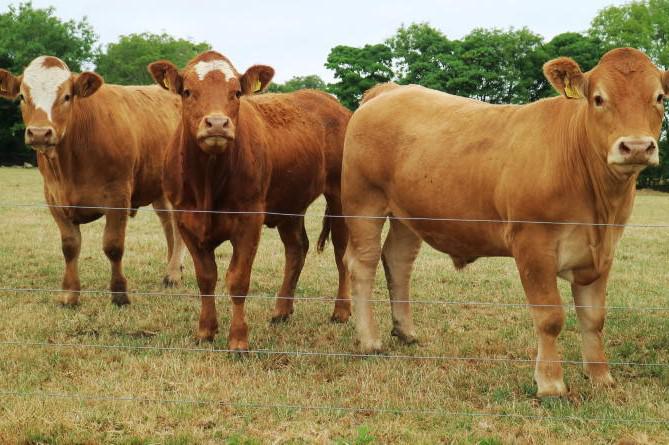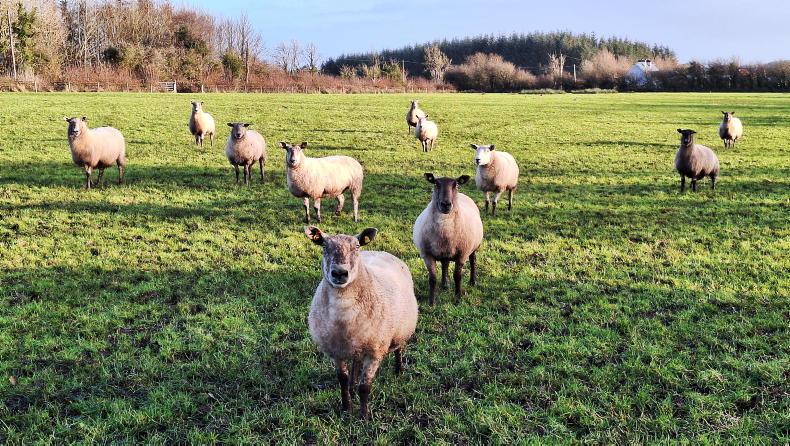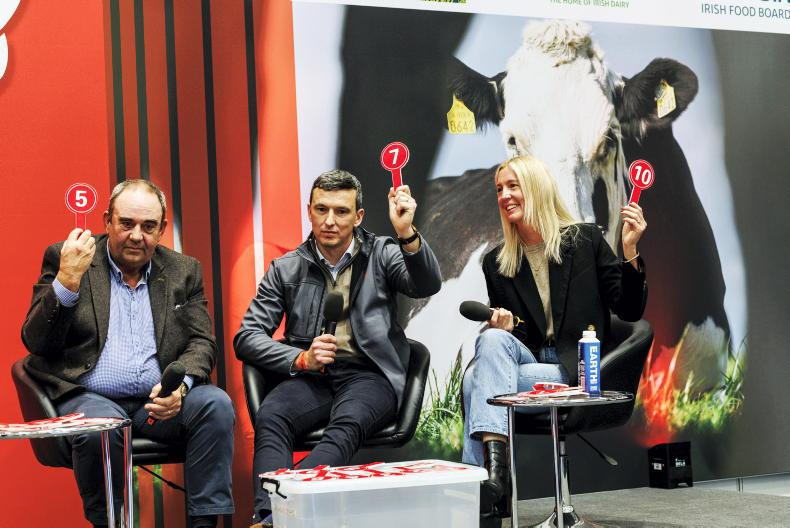The recent heatwave, combined with a severe lack of soil moisture, has left many farmers with a major grazing shortage going into August.
Farmers working on lighter, free-draining soils seem to be the worst affected and many have run out of grass or are working on a rotation of a week to 10 days at best.
The lack of rain during July means there is no regrowth coming back on paddocks after grazing, forcing herd owners to take steps to keep animals fed. In contrast, suckler farms on heavier soils are in an ideal situation, as the current weather has greatly improved stock-carrying capacity of land and grass utilisation.
Where farmers face a grazing shortage, outlined are some tips to stretch grazing on-farm.
Offering silage or hay
Ring feeders are becoming a common sight in fields as farmers look to stretch grazing supplies. Bales made from surplus grass in June can safely be fed back to cattle around four weeks after wrapping.
Ground conditions are excellent and cattle eating from a feeder will cause little or no ground damage.
One silage bale weighing 850kg to 900kg will feed 15 to 20 cows per day, assuming no fresh grass intake or supplementary concentrate is offered.
Feeding a bale every day keeps fodder palatable. During warm conditions, silage can heat and spoil if cattle are not consuming bales quickly enough. If bales start going off before they have been eaten, consider increasing the number of animals in the group for a short period.
Prioritise meal feeding
When feeding meal, every 1kg of ration will reduce grass intake by around 5kg. But target meal to the most responsive or highest priority cattle.
For example, there is little merit in feeding meal to a January/February cow settled in-calf with a low milking ability, especially if her calf is being creep-fed.
Instead, feeding an extra 1kg of meal directly to the calf will give a far greater response in liveweight gain.
Creep-feeding calves 2kg to 4kg/day of concentrate will cost €0.60 to €1.20/day at a ration price of €300/t, and will help maintain a daily gain above 1kg/day, worth at least €2.60/kg in the current live trade.
The extra 1kg of meal will also reduce the calf’s reliance on the milk from the cow, reducing the cow’s feed demand.
In contrast, an April/May-calving cow should currently have higher milking potential and is likely to be cycling. So, feeding meal to these animals will help milk yield and cows get back in-calf.
Stores and forward cattle will also respond to meal feeding. However, if stores are on paddocks with very low grass covers, they will struggle to get enough fibre in their diet.
This can be a problem when feeding higher levels of concentrate, as the risk of acidosis will increase. Therefore, if feeding above 3kg/head, split concentrates across two feeds per day.
Creep-grazing calves
Allowing stronger calves to creep-graze ahead of cows will also reduce the nutritional demand placed on the cow to maintain milk production, helping to reduce grazing demand.
Set the creep feeder up ahead of the calves, or calf troughs that can be moved from paddock to paddock, to entice calves forward.
Raise the electric wire by taping two plastic posts together to let calves creep under and forward.
Graze silage ground
Where second-cut silage has yet to be cut, there is the option to graze some of these standing swards. Use a temporary electric wire to strip graze silage swards. This improves utilisation and when grass supplies do increase, the ungrazed silage swards can be harvested as normal.
Strip grazing and back fencing
Where there is grass ahead of cattle, be it a handful of days or more than a week, strip grazing will help increase grass utilisation and stop animals from spoiling what little grass is still in front of stock. When strip grazing, always move the fence around the same time every day.
It is also important to protect any regrowth. If cattle can’t be closed off a paddock, use a back fence to keep animals off grazed areas that have regrowth coming.
Avoid topping
Where cattle are leaving hard, stemmy grass behind when removed from a paddock, don’t be tempted to hook on the topper to clean off swards. With limited regrowth, this rejected grass will be needed in the next rotation.
Housing forward cattle
House heavy cattle that are 60kg to 80kg from target finishing weight. This will free up more ground for smaller stores or cows and calves, helping stretch the rotation.
Offload fleshed cattle or
late-calving cows
Mart prices are extremely strong at present. Therefore, consider offloading animals carrying flesh, as they will be an easier sell in the live ring. Selling stores will reduce grazing demand, freeing up ground for other stock.
Mart prices will likely ease during autumn, when there is a flush of cattle sold off grass.
Selling now may be the more profitable option.
This may also be the time to offload late spring-calving cows that have a calf at foot, taking repeat offenders out of the herd.
Mineral supplementation
With low grass covers, mineral intake through grazing will be low, so make sure cattle are properly supplemented for trace elements.
This is particularly important for cows in the middle of breeding, or cattle grazing on lighter, rocky soils that have a tendency to be low in minerals.
Fertiliser
There has been some much needed rain this week and it will provide a window for fertiliser. However, it takes grass to grow grass.
On swards with extremely low grass covers, it will still take two to three weeks until there is adequate regrowth to support grazing, even with rain and a dressing of nitrogen this weekend.
Whereas on swards with medium grass covers, a dressing of fertiliser following rain will see grass growth kick in and covers will quickly build again.
Where silage has just been cut and will be needed to stretch grazing rotations, do not slurry aftermaths, as this will affect the palatability of after grass.
Read more
Top tips to keep your machinery running cool this harvest
Thrive: can I stop feeding meal to calves at grass?
The recent heatwave, combined with a severe lack of soil moisture, has left many farmers with a major grazing shortage going into August.
Farmers working on lighter, free-draining soils seem to be the worst affected and many have run out of grass or are working on a rotation of a week to 10 days at best.
The lack of rain during July means there is no regrowth coming back on paddocks after grazing, forcing herd owners to take steps to keep animals fed. In contrast, suckler farms on heavier soils are in an ideal situation, as the current weather has greatly improved stock-carrying capacity of land and grass utilisation.
Where farmers face a grazing shortage, outlined are some tips to stretch grazing on-farm.
Offering silage or hay
Ring feeders are becoming a common sight in fields as farmers look to stretch grazing supplies. Bales made from surplus grass in June can safely be fed back to cattle around four weeks after wrapping.
Ground conditions are excellent and cattle eating from a feeder will cause little or no ground damage.
One silage bale weighing 850kg to 900kg will feed 15 to 20 cows per day, assuming no fresh grass intake or supplementary concentrate is offered.
Feeding a bale every day keeps fodder palatable. During warm conditions, silage can heat and spoil if cattle are not consuming bales quickly enough. If bales start going off before they have been eaten, consider increasing the number of animals in the group for a short period.
Prioritise meal feeding
When feeding meal, every 1kg of ration will reduce grass intake by around 5kg. But target meal to the most responsive or highest priority cattle.
For example, there is little merit in feeding meal to a January/February cow settled in-calf with a low milking ability, especially if her calf is being creep-fed.
Instead, feeding an extra 1kg of meal directly to the calf will give a far greater response in liveweight gain.
Creep-feeding calves 2kg to 4kg/day of concentrate will cost €0.60 to €1.20/day at a ration price of €300/t, and will help maintain a daily gain above 1kg/day, worth at least €2.60/kg in the current live trade.
The extra 1kg of meal will also reduce the calf’s reliance on the milk from the cow, reducing the cow’s feed demand.
In contrast, an April/May-calving cow should currently have higher milking potential and is likely to be cycling. So, feeding meal to these animals will help milk yield and cows get back in-calf.
Stores and forward cattle will also respond to meal feeding. However, if stores are on paddocks with very low grass covers, they will struggle to get enough fibre in their diet.
This can be a problem when feeding higher levels of concentrate, as the risk of acidosis will increase. Therefore, if feeding above 3kg/head, split concentrates across two feeds per day.
Creep-grazing calves
Allowing stronger calves to creep-graze ahead of cows will also reduce the nutritional demand placed on the cow to maintain milk production, helping to reduce grazing demand.
Set the creep feeder up ahead of the calves, or calf troughs that can be moved from paddock to paddock, to entice calves forward.
Raise the electric wire by taping two plastic posts together to let calves creep under and forward.
Graze silage ground
Where second-cut silage has yet to be cut, there is the option to graze some of these standing swards. Use a temporary electric wire to strip graze silage swards. This improves utilisation and when grass supplies do increase, the ungrazed silage swards can be harvested as normal.
Strip grazing and back fencing
Where there is grass ahead of cattle, be it a handful of days or more than a week, strip grazing will help increase grass utilisation and stop animals from spoiling what little grass is still in front of stock. When strip grazing, always move the fence around the same time every day.
It is also important to protect any regrowth. If cattle can’t be closed off a paddock, use a back fence to keep animals off grazed areas that have regrowth coming.
Avoid topping
Where cattle are leaving hard, stemmy grass behind when removed from a paddock, don’t be tempted to hook on the topper to clean off swards. With limited regrowth, this rejected grass will be needed in the next rotation.
Housing forward cattle
House heavy cattle that are 60kg to 80kg from target finishing weight. This will free up more ground for smaller stores or cows and calves, helping stretch the rotation.
Offload fleshed cattle or
late-calving cows
Mart prices are extremely strong at present. Therefore, consider offloading animals carrying flesh, as they will be an easier sell in the live ring. Selling stores will reduce grazing demand, freeing up ground for other stock.
Mart prices will likely ease during autumn, when there is a flush of cattle sold off grass.
Selling now may be the more profitable option.
This may also be the time to offload late spring-calving cows that have a calf at foot, taking repeat offenders out of the herd.
Mineral supplementation
With low grass covers, mineral intake through grazing will be low, so make sure cattle are properly supplemented for trace elements.
This is particularly important for cows in the middle of breeding, or cattle grazing on lighter, rocky soils that have a tendency to be low in minerals.
Fertiliser
There has been some much needed rain this week and it will provide a window for fertiliser. However, it takes grass to grow grass.
On swards with extremely low grass covers, it will still take two to three weeks until there is adequate regrowth to support grazing, even with rain and a dressing of nitrogen this weekend.
Whereas on swards with medium grass covers, a dressing of fertiliser following rain will see grass growth kick in and covers will quickly build again.
Where silage has just been cut and will be needed to stretch grazing rotations, do not slurry aftermaths, as this will affect the palatability of after grass.
Read more
Top tips to keep your machinery running cool this harvest
Thrive: can I stop feeding meal to calves at grass?










SHARING OPTIONS